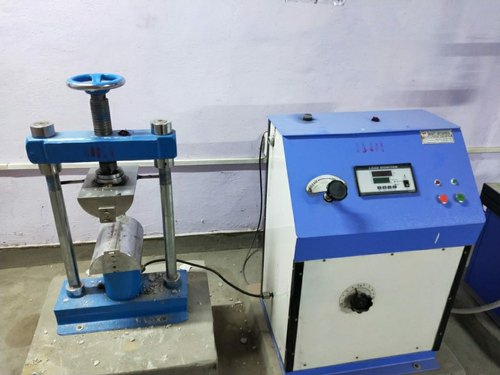Determine splitting tensile strength of cylindrical concrete specimens
OBJECTIVE:
This method covers the determination of the splitting tensile strength of cylindrical concrete specimens
Theory:
Age at Test – Tests shall be made at recognized ages of the test specimens, the most usual being 7 and 28 days. Where it may be necessary to obtain the early strengths, tests may be made at the ages of 24 hours ± ½ hour and 72 hours ± 2 hours. The ages shall be calculated from the time of the addition of water to the dry ingredients.
Number of Specimens – At least three specimens, preferably from different batches, shall be made for testing at each selected age.
APPARATUS:
Testing Machine – The testing machine may be of any reliable type, of sufficient capacity for the tests and capable of applying the load at the rate specified in 5.5. The permissible error shall be not greater than ± 2 percent of the maximum load.
Cylinders –The cylindrical mould shall be of 150 mm diameter and 300 mm height conforming to IS: 10086-1982.
Weights and weighing device, Tools and containers for mixing, Tamper (square in cross section) etc.
PROCEDURE:
1. SAMPLING OF MATERIALS –
Samples of aggregates for each batch of concrete shall be of the desired grading and shall be in an air-dried condition. The cement samples, on arrival at the laboratory, shall be thoroughly mixed dry either by hand or in a suitable mixer in such a manner as to ensure the greatest possible blending and uniformity in the material.
2. PROPORTIONING –
The proportions of the materials, including water, in concrete mixes used for determining the suitability of the materials available, shall be similar in all respects to those to be employed in the work.
3. WEIGHING –
The quantities of cement, each size of aggregate, and water for each batch shall be determined by weight, to an accuracy of 0.1 percent of the total weight of the batch.
4. MIXING CONCRETE –
The concrete shall be mixed by hand, or preferably, in a laboratory batch mixer, in such a manner as to avoid loss of water or other materials. Each batch of concrete shall be of such a size as to leave about 10 percent excess after moulding the desired number of test specimens.
5. MOULD –
The cylindrical mould shall be of 150 mm diameter and 300 mm height conforming to IS: 10086-1982.
6. COMPACTING –
The test specimens shall be made as soon as practicable after mixing, and in such a way as to produce full compaction of the concrete with neither segregation nor excessive laitance.
7. CURING –
The test specimens shall be stored in a place, free from vibration, in moist air of at least 90 percent relative humidity and at a temperature of 27° ± 2°C for 24 hours ± ½ hour from the time of addition of water to the dry ingredients.
8. PLACING THE SPECIMEN IN THE TESTING MACHINE –
The bearing surfaces of the supporting and loading rollers shall be wiped clean, and any loose sand or other material removed from the surfaces of the specimen where they are to make contact with the rollers.

9. Two bearings strips of nominal (1/8 in i.e 3.175 mm) thick plywood, free of imperfections, approximately (25 mm) wide, and of length equal to or slightly longer than that of the specimen should be provided for each specimen.
10. The bearing strips are placed between the specimen and both upper and lower bearing blocks of the testing machine or between the specimen and the supplemental bars or plates.
11. Draw diametric lines an each end of the specimen using a suitable device that will ensure that they are in the same axial plane. Centre one of the plywood strips along the centre of the lower bearing block.
12. Place the specimen on the plywood strip and align so that the lines marked on the ends of the specimen are vertical and cantered over the plywood strip.
13. Place a second plywood strip lengthwise on the cylinder, cantered on the lines marked on the ends of the cylinder. Apply the load continuously and without shock, at a constant rate within, the range of 689 to 1380 kPa/min splitting tensile stress until failure of the specimen
14. Record the maximum applied load indicated by the testing machine at failure. Note the type of failure and appearance of fracture.
OBSERVATIONS:


CALCULATION:
Calculate the splitting tensile strength of the specimen as follows:
T = 2P/πLD
Where
T = Splitting tensile strength
P = Maximum applied load
L = Length, m
D = Diameter
CONCLUSION:
Record the following things
1. i) The average 7 Days Tensile Strength of concrete sample is found to be…..…..
2. ii) The average 28 Days Tensile Strength of concrete sample is found to be…..…..



Comments are closed